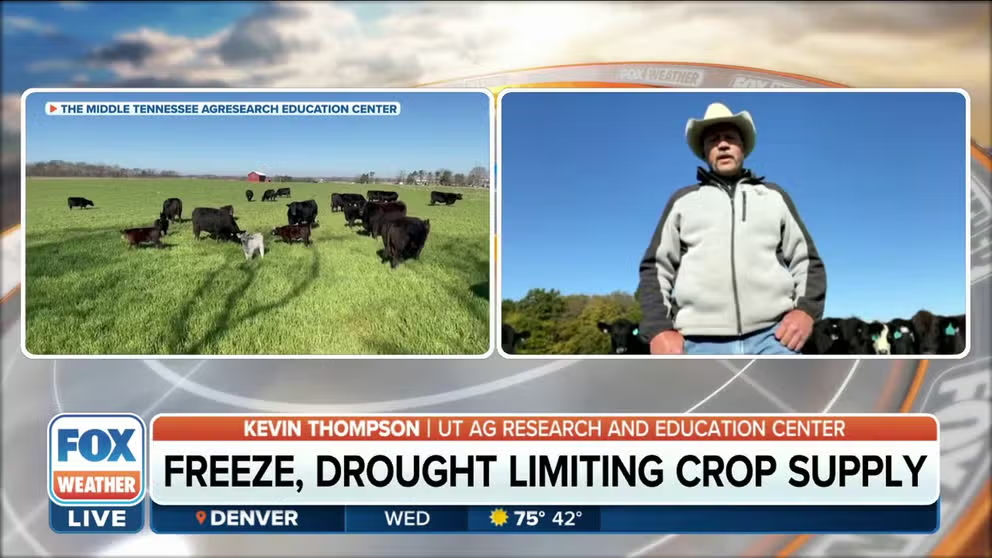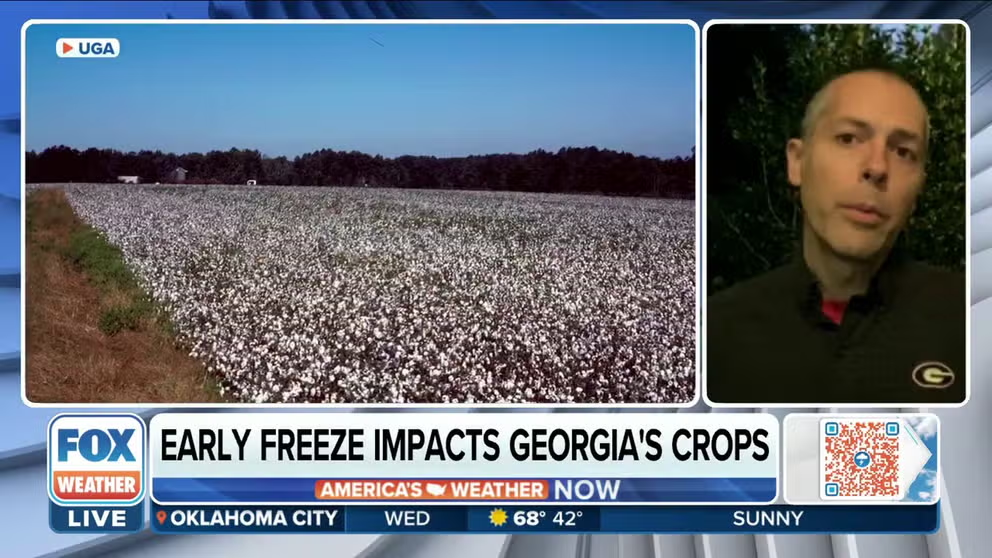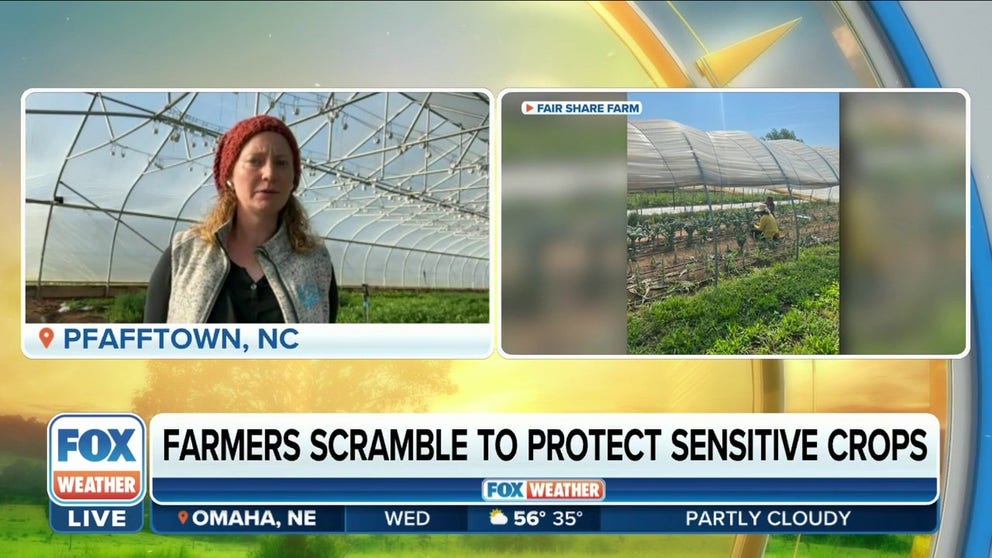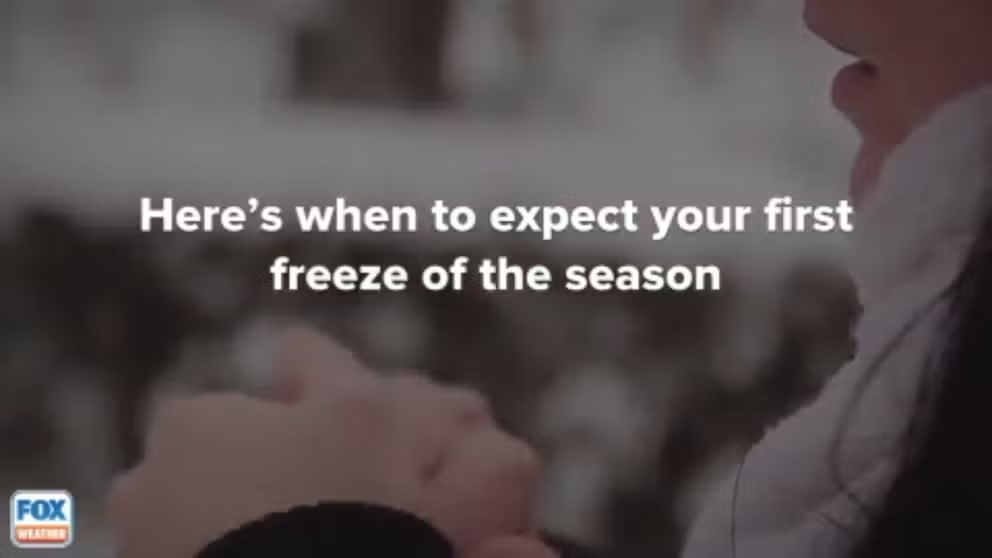October freeze hampers US livestock, crops as impacts passed along to consumers
As if being hammered by drought wasn't bad enough, farmers must now take measures to protect their livestock and crops from the early cold weather. As this fall chill moves in, over 60 million are under frost or freeze alerts.
October freeze creating problems for livestock, crops
Kevin Thompson, Director of the University of Tennessee’s AG Research and Education Center, talks about the impact of the frost/freeze on grasses that could cause severe problems for cattle.
SPRING HILL, Tenn. – Hats, gloves and scarves. We know what it takes to protect ourselves from the freeze. But farmers must take measures to protect livestock and crops from the early cold weather.
The coldest air of the season has invaded the eastern half of the country as a deep dip in the jet stream pulls down the cold air out of Canada.
With frost or freeze alerts issued for over 60 million, Wednesday morning featured some very impressive cold for mid-October. More than 50 low-temperature records fell across the Southeast, Texas and the Missouri Valley.
COLDEST AIR OF SEASON SWEEPS ACROSS EASTERN US, SPREADING FREEZE ALERTS TO FLORIDA
"It is a transition that many of our producers anticipate each and every year. It's that time of year that we start getting frost and heavy freezes," said Kevin Thompson, director of the Agricultural Research and Education Center at the University of Tennessee.
How can Southeast freeze impact Georgia's crops?
University of Georgia Extension Coordinator for Bartow County Paul Pugliese provides insight on FOX Weather.
Freeze, drought limits crop supply
A Freeze Warning signals the end of the growing season, killing off crops. It also deadens the grass used to feed cattle. The heavy freeze kills off the sorghum crops and Johnson grass, which are feed for cattle and livestock, Thompson said.
HERE'S WHEN TO EXPECT THE FIRST FREEZE OF THE SEASON
The cold also impacts the nutrient value of the crop and can cause the plants to turn brown and wilt. And when the plants start to die they produce prussic acid, a form of cyanide, that can be toxic and fatal for livestock.
"A lot of our producers have anticipated that and made preparations ahead of time," Thompson said. "But it's something that we try to inform our producers."
When Freeze or Frost Warnings and Watches are in effect, producers have to hold their cattle and livestock from feeding or clip the plants.
The freeze also adds a bit of strategy to the way producers feed their cattle this year when it stops the growth of cool-season grasses limiting the stockpile going into the fall.
In addition to the freeze, farmers are still battling the ongoing drought that limited the size of their hay crops.
"The Southeast, the Midwest and several other portions of country have experienced severe drought this year, which means that we've got less forage available and had less forage available throughout the spring to harvest our stockpiles of hay," Thompson said.
All these impacts farmers are facing touch on bottom-line profit passed along to consumers at the grocery store.
"All of our input costs are extremely high this time of year," Thompson said. "And then when you place a shortage stored forage in there, we're having to pay more for that and having to go out and purchase it."
However, those in agriculture are resilient, plan ahead, make do with what they have or seek help from others.
"It's a situation where we're going to have some economic challenges," Thompson said. "But not unlike many of the other industries in our country."
Blast of cold air have farmers scrambling to protect sensitive crops
Fair Share Farm owner Emma Hendel joined FOX Weather to talk about how she is protecting some of her crops from the cold air sweeping the country.
Farmers brace for fall freeze
Thursday morning will once again see numerous record lows set in the Southeast before a pattern change brings about a significant ride in temperatures. But all that cold air is affecting growers who are scrambling to protect their crops.
Fair Share Farm owner Emma Hendel of Pfafftown, North Carolina, said they experienced their first frost on the plants Wednesday morning. And as crops begin to thaw out, precautions were made to avoid any damage.
From rolling out row covers to emptying irrigation system pipes, it’s something Hendel is used to dealing with. But it's about two or three weeks earlier in the year than they might expect on average.
WHEN IS THE EARLIEST IT CAN SNOW IN YOUR CITY?
"I wouldn't call it necessarily unseasonable, but generally we're not seeing this type of weather or temperatures until around Halloween," Hendel said. "We did feel a little bit unprepared. But luckily, thanks to looking at the forecast, we were able to pull out all the materials that we needed, and our awesome crew helped us prepare."
And even though the crops got cold and some of them froze up, her cold-hardy plants will be ready for sale as the week rolls on, she adds.
Hendel is currently growing a lot of carrots, beets, broccoli, kale and cabbage, which are seasonally appropriate and built to handle the cold temperatures.
"But always with the first cold snap, you can see some damage to the crops as their systems aren't ready for it yet," she said.
When to expect your first freeze of the season
Here's when you can expect the first freeze of the season in your area.
These types of cold-hardy plants have a natural defense mechanism where they convert their starches into sugars to raise the freezing temperatures in their outer leaves and protect themselves.
HOW COLD DOES IT HAVE TO BE TO SNOW?
The plants most susceptible to the cold weather, Hendel said, are the ones recently transplanted or seeded and just sprouted.
"All of our less mature, our little baby plants that are still growing for the season, we treat them with extra care and cover them because they're not as prepared as the older plants to have those defense mechanisms kick in," she said.
A lot of times when the first dip below freezing happens, Hendel said the plants, like humans, can be a little bit unprepared.
"We can see damage to the tops of carrots, the tops of turnips, the tops of radishes. Anything that has a root underground that we're eating, the part that comes from underneath the ground is generally okay, but we'll see some damage to the tops of those plants," she said.
In the past, Hendel said her kale and broccoli plants can take a bit of a hit at the first frost or freeze, which is why she tends to take precautions and cover.
The FOX Forecast Center said computer forecast models are coming into agreement that a potent storm system will move across the northern Plains early next week. Heavy rain and the potential for snow will be possible as the system tracks east. The exact track of the system will determine where the heaviest amounts and rain and snow will fall.
Be sure to download the free FOX Weather app to track the latest developments in your neighborhood.



